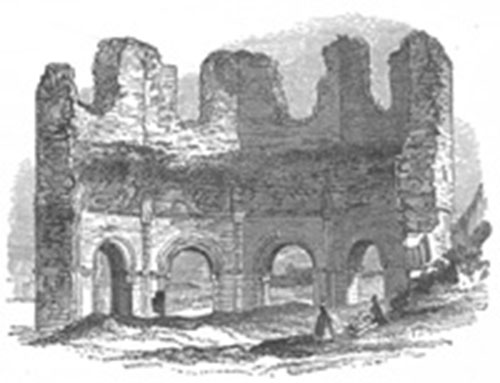Mellifont - Irish Pictures (1888)
From Irish Pictures Drawn with Pen and Pencil (1888) by Richard Lovett
Chapter III: The Valley of the Boyne … continued
« Previous Page | Start of Chapter | Book Contents | Next Page »
The first and most conspicuous object is a lofty, massive tower, through whose arch, only a few years ago, a mill-race was carried, the water of which supplied motive power to a mill which greatly disfigures the otherwise picturesque cluster of ruins. But this, like so many mills all over Ireland, has ceased to be profitable, is now closed, and the mill-race is dry. The tower is 'square in shape and stern in aspect, and bears an elevated turret at its north-eastern angle. This frowning portal, which still remains nearly entire, and was evidently the chief entrance to the monastic enclosure, is an historic evidence, fully as authentic, and more truth-telling than books, of the state of the surrounding country at the time of its erection; and while the peaceful consecrated structures in the enclosure below are landmarks of learning and religion within, this bold castle tells a tale of lawlessness and rapine which raged without. From this point we look down upon a confused mass of ruins, arches, churches, solid blocks of ancient masonry, some standing, others prostrate, several ivy-clad walls and grass-grown mounds, a few dirty thatched cabins, with an ugly square-slated mill, and an adjoining farm-yard.'[1]
This monastery, the first belonging to the Cistercian order of monks in Ireland, was founded in 1142 by Malachy O'Morgair, Archbishop of Armagh, and Donough O'Carroll, King of Oirgialla, i.e., of the counties of Armagh, Monaghan and Lough. The first company of monks were sent over from his monastery at Clairvaulx by the famous St. Bernard, and by them the first foundation was built. 'Then was the underwood cleared away, the oak and the birch fell beneath the woodman's axe, and the wolf and the wild boar were scared from their lurking-place, as the valley rang with the clang of hammers and the sharp chip of the chisel. The bees, for which the place was celebrated, and from which it was named, no longer gathered their winter store from its sweet flowers; and where the crane and the bittern found their resting-place, arose the stately structures of the abbey and surrounding monastic edifices, by far the most gorgeous which had yet been seen in this country. There, where the cooing of the wild pigeon, or the shrill whistle of the lapwing, alone were heard in former years, the tolling of the vesper and the matin bell spread in measured cadences over the surrounding woodlands, and the perfume of incense rose up from the depths of the once solitary and uncultured valley of the Matlock.'[2]
The first abbot was Christian O'Conarchy, appointed in 1145; here, in 1157, a famous synod was held, attended by seventeen bishops and Murtough O'Loughlin, King of Ireland, who made rich presents to the abbey; here, in 1193, died the ill-fated Dearvorgil. It was bestowed upon Sir Gerald Moore at the Dissolution of the Monasteries, and he changed it into a magnificent residence. Subsequently it was captured by the Irish in 1641.
The chief ruins within the enclosure are St. Bernard's Chapel and the Baptistery. The former when complete must have been a beautiful and highly ornate example of the Norman or Early English pointed style. The structure known as the Baptistery is unique, there being no other like it in Ireland. Originally it was an octagonal building, standing upon a series of splendidly built arches. In the opinion of good judges it dates from the early part of the twelfth century. Around these more important structures are the remains of pillars, crypts, arches, and all the evidences of the existence here in the past of a large church and extensive monastery. Sir W. Wilde has noted one important and significant fact connected with these ruins. 'One cannot fail to be struck with the remarkable fact that there is not a single characteristic emblem or element of true Irish ecclesiastical architecture at Mellifont; no round tower, no crosses, no inscriptions on tombs, no doorways with straight lintels and inclining jambs, and no knotted tracery, indicative of early Irish art. Everything we meet here is foreign.'[3]
« Previous Page | Start of Chapter | Book Contents | Next Page »
NOTES
[1] The Boyne and the Blackwater, p. 279.
[2] Ibid. p. 285.
[3] The Boyne and the Blackwater p. 292.

